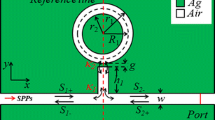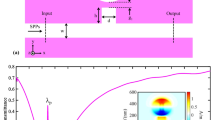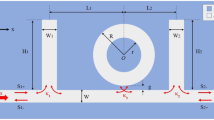Abstract
An analog of electromagnetically induced transparency (EIT) is investigated in a metal-insulator-metal (MIM) waveguide structure consisting of a stub waveguide and a side-coupled cross resonator. The transmission properties of this plasmonic MIM waveguide structure are numerically studied by the finite element method. The results show that there are double EIT-like phenomena as well as multiple EIT-like peaks in the transmission spectra by adding another stub. The transparency windows not only can be manipulated by changing the coupling distance between the stub and the cross resonator and the length of the horizontal and vertical cavity but also show a red shift with the increase of the refractive index n of the medium in the cross resonator. The designed plasmonic MIM waveguide structure is able to serve as a filter with a transmission rate of over 80 % and is easy to detect the refractive index of the filled media in the cross resonator, which indicates the potential applications in filtering and sensing.








Similar content being viewed by others
References
Baba T (2008) Slow light in photonic crystals. Nat Photonics 2(8):465–473
Barnes WL, Dereux A, Ebbesen TW (2003) Surface plasmon subwavelength optics. Nature 424:824–830
Boller KJ, Imamolu A, Harris SE (1991) Observation of electromagnetically induced transparency. Phys Rev Lett 66(20):2593–2596
Chen JJ, Li Z, Lei M, Fu XL, Xiao JH, Gong QH (2012) Plasmonic Y-splitters of high wavelength resolution based on strongly coupled-resonator effects. Plasmonics 7(3):441–445
Chen JJ, Li Z, Zou YJ, Gong QH (2013) Coupled-resonator-induced fano resonances for plasmonic sensing with ultra-high figure of merits. Plasmonics 8:1627–1632
Chen JJ, Sun CW, Gong QH (2014) Fano resonances in a single defect nanocavity coupled with a plasmonic waveguide. Opt Lett 39:52–55
Chen Z, Wang WH, Cui LN (2015) Spectral splitting based on electromagnetically induced transparency in plasmonic waveguide resonator system. Plasmonics 10:721–727
Falk AL, Koppens FHL, Yu CL, Kang K, Snapp ND, Akimov AV, Jo MH, Lukin MD, Park H (2009) Near-field electrical detection of optical plasmons and single-plasmon sources. Nat Phys 5:475–479
Gramotnev DK, Bozhevolnyi SI (2010) Plasmonics beyond the diffraction limit. Nature Photon 4:83–91
Guo YH, Yan LS, Pan W, Luo B, Wen KH, Guo Z, Li HY, Luo XG (2011) A plasmonic splitter based on slot cavity. Opt Express 19(15):13831–13838
Harris SE, Field JE, Imamoglu (1990) A nonlinear optical processes using electromagnetically induced transparency. Phys Rev Lett 64(10):1107–1110
Jin XR, Park J, Zheng HY, Lee S, Lee Y, Rhee GY (2011) Highly-dispersive transparency at optical frequencies in planar metamaterials based on two-bright-mode coupling. Opt Express 19(22):21652–21657
Johnson PB, Christy RW (1972) Optical constants of the noble metals. Phys Rev B 6(12):4370–4379
Kim KY, Cho YK, Tae HS, Lee JH (2006) Light transmission along dispersive plasmonic gap and its subwavelength guidance characteristics. Opt Express 14:320–330
Lai G, Liang RS, Zhang YJ, Bian ZY, Yi LX, Zhan GZ, Zhao RT (2015) Double plasmonic nanodisks design for electromagnetically induced transparency and slow light. Opt Express 23(5):6554–6551
Lin XS, Huang XG (2008) Tooth-shaped plasmonic waveguide filters with nanometeric sizes. Opt Lett 33:2874–2876
Liu HC, Amnon Y (2009) Grating induced transparency (GIT) and the dark mode in optical waveguides. Opt Express 17(14):11710–11718
Liu N, Langguth L, Weiss T, Kastel J, Fleischhauer M, Pfau T, Giessen H (2009) Plasmonic analogue of electromagnetically induced transparency at the Drude damping limit. Nat. Mater 8:758–762
Liu N, Weiss T, Mesch M, Giessen H (2010) Planar metamaterial analogue of electromagnetically induced transparency for plasmonic sensing. Nano Lett 10(4):1103–1107
Lu H, Liu XM, Wang LR, Gong YK, Mao D (2011a) Ultrafast all-optical switching in nanoplasmonic waveguide with Kerr nonlinear resonator. Opt Express 19(4):2910–2915
Lu H, Liu XM, Mao D, Gong YK, Wang GX (2011b) Induced transparency in nanoscale plasmonic resonator systems. Opt Lett 36(16):3233–3235
Lu H, Liu XM, Mao D, Wang GX (2012a) Plasmonic nanosensor based on Fano resonance in waveguide-coupled resonators. Opt Lett 37(18):3780–3782
Lu H, Liu XM, Mao D (2012b) Plasmonic analog of electromagnetically induced transparency in multi-nanoresonator-coupled waveguide system. Phys Rev A 85(5). doi:10.1103/PhysRevA.85.053803
Ni B, Chen XY, Xiong DY, Liu H, Hua GH, Chang JH, Zhang JH, Zhou H (2015) Infrared plasmonic refractive index-sensitive nanosensor based on electromagnetically induced transparency of waveguide resonator systems. Opt Quant Electron 47:1339–1346
Park J, Kim H, Lee B (2008) High order plasmonic Bragg reflection in the metal–insulator–metal waveguide Bragg grating. Opt Express 16:413–425
Tao J, Huang XG, Lin XS, Zhang Q, Jin XP (2009) A narrow-band subwavelength plasmonic waveguide filter with asymmetrical multiple teeth-shaped structure. Opt Express 17:13989
Totsuka K, Kobayashi N, Tomita M (2007) Slow light in coupled-resonator-induced transparency. Phys Rev Lett 98(21). doi:10.1103/PhysRevLett.98.213904
Wu TS, Liu YM, Yu ZY, Peng YW, Shu CG, Ye H (2014) The sensing characteristics of plasmonic waveguide with a ring resonator. Opt Express 22(7):7669–7677
Wang G, Lu H, Liu X (2012) Dispersionless slow light in MIM waveguide based on a plasmonic analogue of electromagnetically induced transparency. Opt Express 20:20902–20907
Zhang XY, Wang LL, Chen Z, LN Cui C, Shang YF, Zhao GY, Duan JB, Liu LY (2015) The line shape of double-sided tooth-disk waveguide filters based on plasmon-induced transparency. Chin Phys Lett 32(5). doi:10.1088/0256-307X/32/5/054209
Acknowledgments
This work was supported by the National Natural Foundation of China (Nos. 11304243 and 11604198), the National Science Basic Research Plan in Shaanxi Province of China (Nos. 2013JM8004 and 2014JQ1039), the Cultivating Fund in Xi’an University of Science and Technology (No. 201242), and the Xi’an University of Science and Technology, Dr. Scientific Research Fund (No. 2015QDJ011).
Author information
Authors and Affiliations
Corresponding author
Ethics declarations
Funding
This study was funded by the National Natural Foundation of China ( Nos. 11304243 and 11604198), the National Science Basic Research Plan in Shaanxi Province of China (Nos. 2013JM8004 and 2014JQ1039), the Cultivating Fund in Xi’an University of Science and Technology (201242), and the Xi’an University of Science and Technology, Dr. Scientific Research Fund (No. 2015QDJ011).
Conflict of Interest
The authors declare that they have no conflict of interest.
The manuscript has not been submitted to more than one journal for simultaneous consideration.
The manuscript has not been published previously (partly or in full).
A single study is not split up into several parts to increase the quantity of submissions and submitted to various journals or to one journal over time.
No data have been fabricated or manipulated (including images).
No data, text, or theories by others.
Consent to submit has been received explicitly from all co-authors, as well as from the responsible authorities.
Authors whose names appear on the submission have contributed sufficiently to the scientific work and therefore share collective responsibility and accountability for the results.
Rights and permissions
About this article
Cite this article
Pang, S., Huo, Y., Xie, Y. et al. Tunable Electromagnetically Induced Transparency-Like in Plasmonic Stub Waveguide with Cross Resonator. Plasmonics 12, 1161–1168 (2017). https://doi.org/10.1007/s11468-016-0371-6
Received:
Accepted:
Published:
Issue Date:
DOI: https://doi.org/10.1007/s11468-016-0371-6




